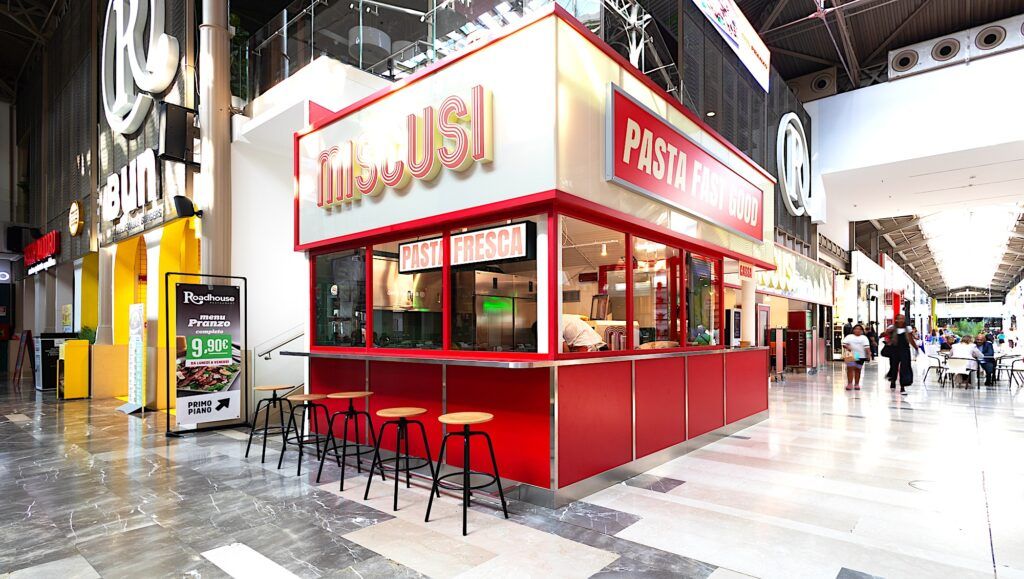The location
The restaurant is part of the Food Court of the Milanofiori shopping center which is located in Viale Milano Fiori in Assago, in the province of Milan. It is one of the largest and most popular shopping mall in Lombardy region, as it can be easily reached by public transport from the city of Milan and by car following the West ring road.
The project
This unit represents a further formalization of the fast casual format created by the chain, a model successfully tested in embryonic form by the brand in the location of the Porta Nuova Food District, in Piazza Gae Aulenti.
The design took place in synergy with the client’s requests and needs, taking into account the indications and requests for stylistic alignment and conservation of volumes expressed by the owners of the shopping centre.
All food & beverage set-up projects, inserted in shopping centers and food courts, require a delicate feasibility verification process that fulfills the wishes and enhances the characterizing aspects of the format, respecting the indications and technical requirements of the shopping center.
This project is characterized by a large and articulated front of significant length, approximately 30 linear metres, which helps to visually distinguish and give unity to the store, detaching it from the surrounding catering activities, while maintaining an aesthetic coherence with the spaces and volumes of the Food Court.
The perimeter of the store is therefore delineated by a translucent band which incorporates the satellite kiosk, allowing a glimpse of the architecture and layout of the spaces of the shopping centre. Specifically, it was necessary not to deny the architectural structure behind it and to preserve the visual perception of the two existing arches and staircase.
Two important backlit box-shaped signs are installed on this large band and all the interventions were carried out respecting the brand’s color palette.
The project divided the venue into three macro-environments:
1) satellite kiosk (pasta artisanal production area)
2) kitchen room
3) dining area
Satellite kiosk
The satellite kiosk coincides with the pasta production area and constitutes the most visually evident protruding element of the point of sale. The load-bearing structure was made with an iron core, partly glazed and partly covered in imitation red formica. To suggest the double function of kiosk and showcase for preparation, the satellite block integrates a support shelf for customers in satin-finish steel. These stool seats enjoy a privileged view of the bronze drawing production, a characterizing element and reason for the brand’s qualitative uniqueness.
The satellite kiosk is configured as a sort of peninsula with respect to the commercial unit, deliberately very visible from different positions of the food court, becoming an important peculiarity in terms of corporate communication and storytelling.
The kitchen
The niche that houses the kitchen houses the visible pasta cooking and creaming line, an element that reiterates the values of authenticity and gastronomic genuineness of the brand, as is the case with the production visible from the windows of the satellite kiosk. The entire room is covered with green tiles, another color attributable to the Miscusi palette.
The food pass is made with the same red formica and steel-like finishes already seen in the satellite kiosk.
The aesthetic reference suggests an Italian “bar – diner” atmosphere of times gone by, in strong aesthetic contrast but well integrated with the tech elements of the point of sale. The diner feel and the presence of backlit box-shaped signage elements, which indicate the pickup and take away areas, suggest the use of the dishes according to the fast food restaurant model. The effective lighting of the kitchen area is achieved with white track spotlights.
Dining room
A stoneware grit-effect tile was laid on the ground which reproduces the ancient cement compounds characterized by the presence of stone chips and marble granules, now commonly referred to as terrazzo veneziano. To add interest to the installation, a checkerboard effect was created, contrasting light and dark tiles.
Even on the perimeter walls of the dining room we find a section of green tiles, highlighted by a contrasting black band, which acts as a cable cover for customer sockets and special systems, becoming a sort of boiserie moulding.
A line of orange padded benches with a contrasting black iron structure is placed against the existing walls.
To these seats are added polenta yellow chairs with black metal tubing. The pine green laminate table tops reflect the color of the tiles, resting on a metal foot, with exposed plywood profiles.
The room is filtered from the food court by furnishing wings which house the supporting structure and the wiring of the digital kiosks and all the advertising screens. Following the instructions and vision of the client, this filter efficiently conveys and separates the customer flows during the order phase, guaranteeing intimacy for the internal room.
Also of great interest is the architectural ceiling solution for the dining room which houses lighting fixtures with glass bells, mounted on an irregular metal grid, giving the effect of a random arrangement. Ceiling left unfinished, enhancing the predalles structures of the shopping center thanks to the lighting.

